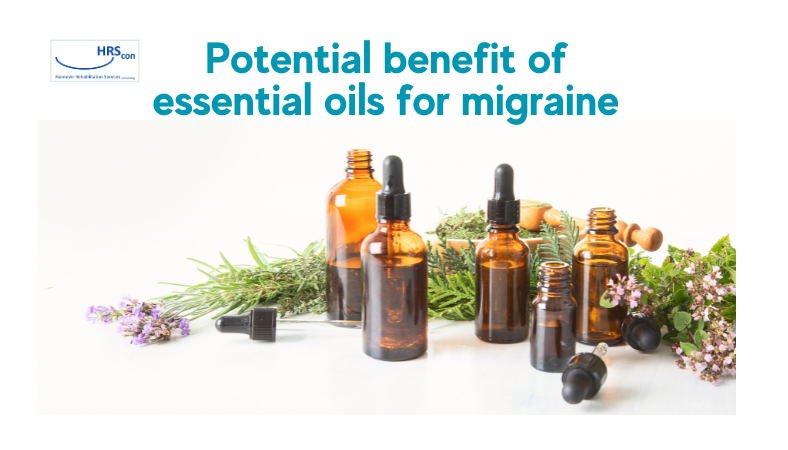According to the study in 2016, Migraine is the second biggest cause of disability worldwide. There are two main types of migraines: one with aura and one without aura.
For migraines without aura, the symptoms include a headache on one side of the head that pulses and lasts for 4 to 72 hours. Doing physical activities or moving your head can make it worse. Other signs are sensitivity to light and sound, feeling sick, throwing up, and other problems.
Migraines with aura are a bit different. Before the headache starts, there are signs called aura symptoms. These can happen hours or even days before the headache. Aura symptoms include temporary changes in sight, feeling, or other things in the nervous system. After the aura, the migraine symptoms begin (Anon., 2018b) IHS.
The symptoms of migraine can be alleviated by conventional drugs, such as NSAIDs, triptans, ergotamine, and others. Additionally there has been an increased of interest that essential oils could help migraine. Belows are some essential oils that could help migraine and have been summarized in a review paper (Yuan et al. 2021)
“Lavender Essential Oil
Active ingredients: Linalool (33.25%); Linalyl acetate (35.35%); Camphor (17.77%); Borneol (4.26%); 1,8-cineol (8.1%)
1%, 10%,100% concentration of essential oils significantly reduces the number of head scratches in migraine rats; All migraine sufferers had their migraine symptoms completely or partially relieved within the first 2 h of use of essential oils, nausea, vomiting, photophobia, voice fear, and olfactory disturbance improved. (Sasannejad et al., 2012; Chen et al., 2015)
Pepperrmint Essential oil
Active ingredients: Menthol (23.0%–47.9%); Menthone (10.6%–38.5%); Limonene (0.3%–18.5%); 1,8-cineol (0.3%–9.9%);
Menthyl Acetate (0.5%–7.7%); neoMenthol (0.2%–7.4%); α-Pinene (0.2%–6.5%).
The symptoms of the patients wererelieved after administration of 5min, and the intensity and frequency of headache decreased compared with those befor treatment. (de Groot and Schmidt, 2016; Rafieian-Kopaei et al., 2019)
Angelicae Dahuricae Radix essential oil
Active ingredients: Dodecyl alcohol (13.71%); Elemene (7.54%); Hexadecanoic acid, ethyl ester (7.32%); α-Pinene (6.25%); 1-Pentadecanol (6.08%); Linoleic acid ethyl ester (3.92%)
140mg/kg, 70mg/kg, 35mg/kg essential oil can significantly reduce the serum NO level in rats; 140mg/kg and 70mg/kg can significantly reduce NO level in brain tissue, CGRP level in plasma and increase ET level. (Sun et al. 2017)
Chuanxiong Rhizoma essential oil
Active ingredients: Ligustilide (58%); Butylidenephthalide (5.29%); Sabinene (6.08%)
The essential oils of 90.0 μl/kg and 135.0 μl/kg significantly inhibited the expression of c-fos; 45.0 μl/kg and 135.0 μl/kg can significantly reduce plasma CGRP levels and increase 5-HT and ET levels; 45.0 μl/k and 90.0 μl/kg significantly increased plasma ET levels. 2 h following administration of the medicine, the migraine symptoms of the patients with an acute attack were relieved. (Peng et al., 2009; Li,2012)
Chamomile essential oil
Active ingredients: Chamazulene (9.75%); β-Caryophyllene (6.86%); Bisabolone oxide A (57.37%); Bisabolol oxide A (14.29%); Methyl ester 5,8,11-heptadecatriynoic acid (5.08%)
The symptoms of pain, nausea, vomiting, photophobia, and phonophobia in migraine patients were significantly alleviated after 30min. (Zargaran et al. 2018)
Anise essential oil
Active ingredients: Anethole (E− ) (89.342%); Limonene (1.25%); Carvone (3.9%); Himachalene (γ-)
The frequency of migraine attacks decreased from 3.45 (±1.89) times/week to 1.89 (±1.94), and the average duration decreased from 17.38 (±29.22) h to 5.18 (±7.72). (Mosavat et al. 2019)
Garlic essential oil
Active ingredients: Diallyldisulfide; Diallyl trisulfide; Diallyl sulfide
After 60 min of administration of essential oils, the dose (1, 10, 100, 500 μl/L) dependently reduced potassium chloride-induced inhibition of rat cortical spreading. (Marschollek et al. 2017)
Basil essential oil
Active ingredients: 1,8-cineol (3%); Terpinene(γ-) (1.5%); Linalool (1.5%); Estragole (93%); Eugenol (1%)
The pain intensity and attack frequency of patients decreased with the passage of time of the study. (Ahmadifard et al. 2020)
Rose (Rosa damascena Mill.) oil
Active ingredients: Citronellol (3.48%); Geraniol (1.23%)
Relieved the pain intensity of patients with hot migraine syndrome (red eyes, photophobia, spicy taste, and facial heat during headaches).( Niazi et al. 2017)
Mixed essential oil
Most patients’ symptoms disappear within 20 days, and there is no recurrence within 1 year; some patients have prolonged the onset cycle, and the pain level is significantly reduced compared with before. (Du et al. 2007).”
Reference
Li, B., 2012. Clinical Study on Immediate Analgesic Effect of Chuanxiong Oil Soft Capsule on Acute Attack of Migraine (Blood Stasis Syndrome). Chengdu University of traditional Chinese Medicine.

